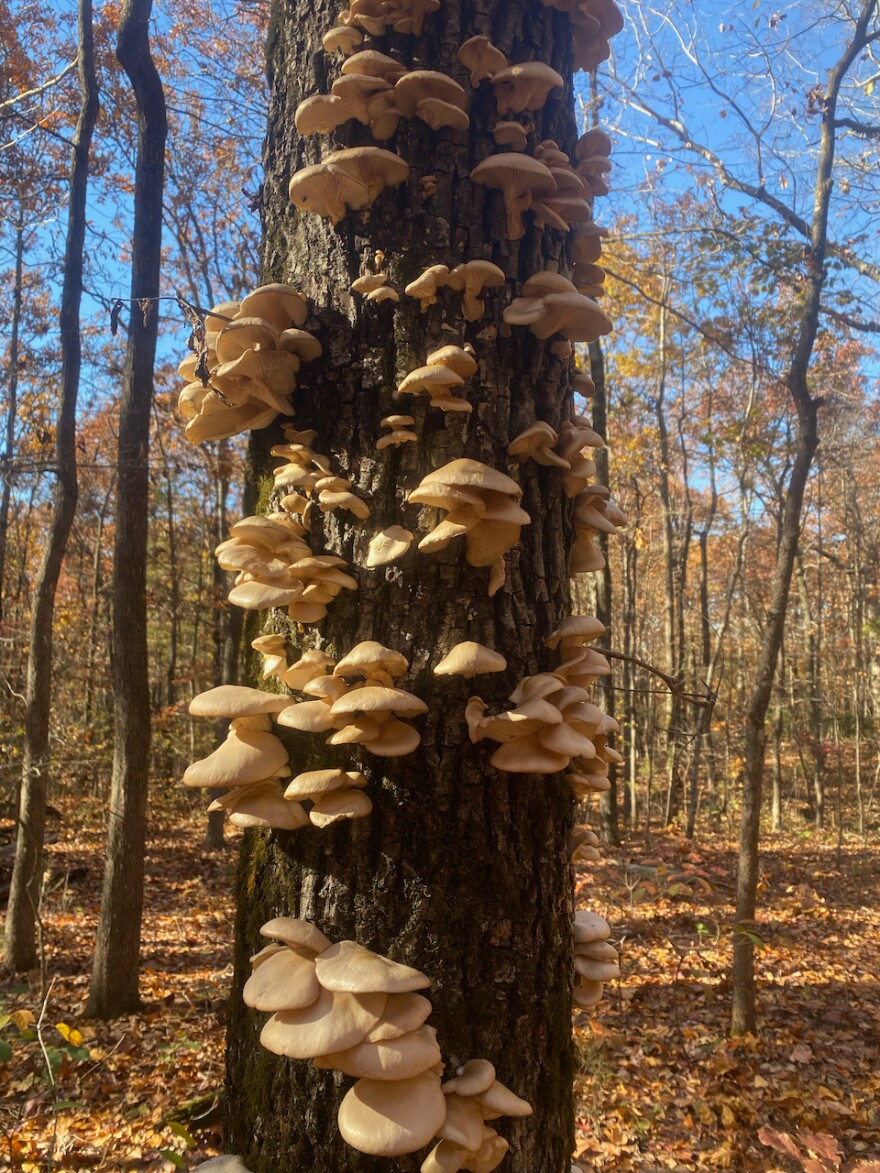Jake Parette carefully picks his way through a dense brambly trail on Frog Bayou watershed north of Lake Fort Smith State Park, scanning the forest for coveted morel mushrooms. Beyond a rushing milky turquoise stream, the trail leads to the edge of a shaded riparian forest -- prime morel habitat.
"You've got your ash, sycamore, dark dherry," Parette said pointing to trees overhead. "It's a little patch, but you can see where the soil has been disturbed, pretty recently I'd say."

The ground is roughed up, all the morel mushrooms taken. Parette believes in responsible harvesting, which means leaving mushrooms for others to discover. Still, he says, this plundered morel habitat is not destroyed.
"When they get picked, the mushrooms drop spores, millions of little spores and those blow off in the wind, creating other mushrooms."
Parette said some foragers use knives to harvest, while others simply pinch and pull them up from the forest floor, showing the bottom of his waxed canvas collection pouch clipped to his belt.

"Mushroom hunters use this bag which has a mesh bottom so as you're walking through the woods, you're spreading spores all over the place."
Mushrooms -- classified as fungi -- don't shed seeds or have roots, and don't require sunlight to grow. Morel mushrooms are easy to spot, with tall cream-colored stems and golden to dark brown conical honeycombed caps. Morels tend to emerge in early March on the Ozarks, as temperatures warm, disappearing by late April. They frequently pop up in the spring on charred landscapes, after forest fires or prescribed burns. Morels tend to taste nutty and sweet when sauteed in butter.
"Our next mushroom season is probably my favorite, which is the chanterelles," Parette said. "They're easier to find, like hunting easter eggs. Kids can see them from a mile away. They're bright orange, so you can't miss them."

Chanterelles produce golden funnels from early summer into fall, preferring the filtered light of older-growth forests. When prepared, they have a slightly fruity flavor, with notes of apricots or peaches.
"Then you get into your oysters and lion's mane, especially lion's mane, that's the one I seek," Parette said. "That's a delicacy."
Lion's mane mushrooms, also known as yamabushitake or old man's beard, grow on fallen oak, beech, or maple trees from late summer to fall. The solid ball-shaped snow-white mushrooms are covered in downward-hanging strands. Lion's mane has a mildly sweet shellfish flavor.

Oyster mushrooms, blue-grey to white shell-shaped fungi, grow in gregarious clusters on dead trees and stumps year-round on the Ozarks, Parette said.

If unfamiliar with mushroom foraging, always source an expert, Parette said, because certain species that appear culinary-safe can be deadly poisonous. Come late spring, summer, and fall also watch out for snakes and ticks.
Our fearless guide, Lt. Jake Parette, who grew up in Alma, Arkansas, is a decorated U.S. Army Veteran.
"I served four years in the U.S. Army Infantry up in Alaska then deployed to Afghanistan," he said. "I received a Purple Heart. I was medically discharged from the U.S. Army and started my career in law enforcement in Mulberry, as school resource officer. I really enjoyed that. I'm currently with Kibler Police Department, serving as a Patrol Lieutenant. I really got into the foraging after my time in the service. I found peace being outside as well as healing. What better medicine than being out here."
Parette and his spouse, a nurse, are raising a boy and two girls. He serves as both regional Chapter and State Adjutant for the Military Order of the Purple Heart. He said he first learned to forage for mushrooms and native plants, taking classes at Ozark Folkways in Winslow.
"I don't do a lot of guided tours," he said. "But I do take people that are like minded individuals who are responsible and genuinely care about ecosystems -- not just wanting to find mushrooms."
We leave the morel habitat to trek up a steep mountainside into a dense hardwood forest, through large plots of blooming indigo wild iris and across several trickling cold-water seeps
"This is a prime location for your oysters and your chanterelles," Parette said. "You see all this moss? That's a good indicator for me. Now that's not a guarantee but anywhere there's a lot of moisture coming from these streams, there tends to be a lot of chanterelles. And these logs over waterways are a good spot for oysters and lion's mane as well."
Parrette said late June is a good time to hunt for chanterelle as well as Oyster mushrooms which cling to both standing and fallen hardwood trees.

"Oysters will look like smooth seashells," he said. "And around here are going to be pearl white."
Parette has spent more than a decade foraging for mushrooms on the Ozark Highlands and Arkansas River Valley where he said he's seeing changes due to extreme climate as well as invasive species.
"It scares me," he said. "But mushrooms have been here long before us and will be here long after us. But definitely we are impacting them."
Parette believes that experiencing the beauty and value of wild mushroom habitats will spur conservation. He suggests consulting with experts if you wish to learn more — and to stay safe.








